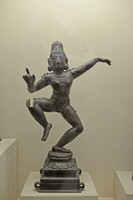| dc.coverage.spatial | Site: Prince of Wales Museum of Western India (Mumbai, Mahārāshtra, India) B 126 | en_US |
| dc.coverage.temporal | ca. 13th century (creation) | en_US |
| dc.creator | unknown (Indian (South Asian)) | en_US |
| dc.date | 1200-1299 | en_US |
| dc.date.accessioned | 2016-08-23T18:14:02Z | |
| dc.date.available | 2016-08-23T18:14:02Z | |
| dc.date.issued | 1200-1299 | en_US |
| dc.identifier | 268035 | en_US |
| dc.identifier.other | archrefid: 3391 | en_US |
| dc.identifier.uri | http://hdl.handle.net/1721.3/184349 | |
| dc.description | Overall view; The Tamil-speaking Chola dynasty was prominent in south India until the 13th century CE, when it was brought down by the attacks of a revived Pandya dynasty and the Hoysala rulers of Karnataka. Sambandar (also called Thirugyana Sambandar, Tirugnana Sambanthar, Campantar, Champantar, Jnanasambandar, Gnanasambandar) was a young Saiva poet-saint of Tamil Nadu who lived around the 7th century CE. Sambandar's hymns to Shiva were later collected to form the first three volumes of the Tirumurai, the religious canon of Tamil Saiva Siddhanta. The wave of Shaivite devotionalism that swept through late classical and early medieval India redefined Karnataka and Tamil Nadu and legitimized several ruling dynasties, including the Chola. Sambandar is portrayed as a child; he supposedly composed his first verse hymn at age 3; he vigorously opposed Buddhism and Jainism. Source: Wikipedia; http://en.wikipedia.org/wiki/Main_Page (accessed 4/9/2015) | en_US |
| dc.format.medium | bronze | en_US |
| dc.rights | © Scott Gilchrist, Archivision, Inc. | en_US |
| dc.subject | human figure | en_US |
| dc.subject | literary or legendary | en_US |
| dc.subject | saints | en_US |
| dc.subject | Hinduism | en_US |
| dc.subject | dance | en_US |
| dc.subject | Saivism | en_US |
| dc.subject | Shaivism | en_US |
| dc.subject | Chola | en_US |
| dc.title | Dancing Jnanasambandar | en_US |
| dc.title.alternative | Dancing Sambandar | en_US |
| dc.type | image | en_US |
| dc.rights.access | Licensed for educational and research use by the MIT community only | en_US |
| dc.identifier.vendorcode | 7A2-IN-PWM-DJNAN-A01 | en_US |
| vra.culturalContext | Indian (South Asian) | en_US |
| vra.technique | casting (process) | en_US |
| vra.worktype | sculpture (visual work) | en_US |
| dc.contributor.display | unknown (Indian) | en_US |

